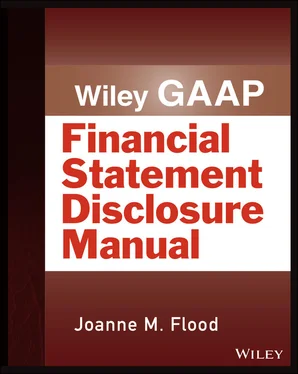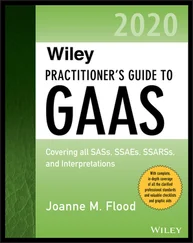AUTHORITATIVE LITERATURE
Subtopic
ASC 235, Notes to Financial Statements , contains one Subtopic:
ASC 235‐10, Overall, which addresses “the content and usefulness of the accounting policies judged by management to be most appropriate to fairly present the entity's financial statement.”
ASC 235 applies to all entities and has no scope exceptions.
When preparing disclosure notes, entities should consider the purpose of the disclosure—to provide users with information that assists them in assessing the entity's performance and cash flow. The notes should enhance the information presented on the face of the financial statements, provide clarity, and be organized in a logical manner. Entities should also word notes in plain English, consider tabular formats, and cross references.
The following five disclosure techniques are used in varying degrees in contemporary financial statements:
1 Parenthetical explanations
2 Notes to the financial statements
3 Cross‐references
4 Valuation allowances (sometimes referred to as “contra” amounts)
5 Supporting schedules.
Parenthetical Explanations
Information is sometimes disclosed by means of parenthetical explanations appended to the appropriate statement of financial position caption. Parenthetical explanations have an advantage over both notes to the financial statements and supporting schedules. Parenthetical explanations place the disclosure prominently in the body of the statement instead of in a note or schedule where it is more likely to be overlooked. For example:
Example—Parenthetical Explanations
| Common stock ($10 par value, 200,000 shares authorized, 150,000 issued) |
$1,500,000 |
Notes to Financial Statements
If the information cannot be disclosed in a relatively short and concise parenthetical explanation, a note disclosure is used. For example, see the following.
Example—Internal Reference to Note
| Inventories (see note 1) |
$2,550,000 |
The notes to the financial statements would contain the following:
Note 1: Inventories are stated at the lower of cost or market. Cost is determined using the first‐in, first‐out (FIFO) method.
Cross‐referencing is used when there is a direct relationship between two accounts on the statement of financial position. For example, among the current assets, the following might be shown if $1,500,000 of accounts receivable were pledged as collateral for a $1,200,000 bank loan.
Example—Cross‐References to Other Line Items
| Accounts receivable pledged as collateral on bank loan payable |
$1,500,000 |
Included in the current liabilities would be the following:
| Bank loan payable—collateralized by accounts receivable |
$1,200,000 |
Valuation Allowances or Contra Accounts
Valuation allowances are used to reduce or increase the carrying amounts of certain assets and liabilities. Accumulated depreciation reduces the carrying value of property, plant, and equipment, and a bond premium (discount) increases (decreases) the face value of a bond payable as shown in the following illustration.
Example—Valuation Allowances or Contra Accounts
| Equipment |
$18,000,000 |
|
| Less accumulated depreciation |
(1,625,000) |
$16,375,000 |
| Bonds payable |
$20,000,000 |
|
| Less discount on bonds payable |
(1,300,000) |
$18,700,000 |
| Bonds payable |
$20,000,000 |
|
| Add premium on bonds payable |
1,300,000 |
$21,300,000 |
Disclosures have drawn the attention of both the FASB and the SEC. As the disclosure requirements have accumulated over the years, there has been a growing concern about information overload and whether more is necessarily better. Both the FASB and the SEC have initiatives to improve disclosures.
The FASB currently has projects on:
Income taxes
Interim reporting
Inventory
Government assistance
Disaggregation of performance information
Not‐for‐profit reporting of gifts‐in‐kind
Segment reporting
Simplifying the balance sheet classification of deb t
The most recent information on the FASB initiative can be found in this volume in the chapter on ASC 105.
In August 2018, the SEC as part of its Disclosure Simplification Initiative published a rule reducing the public company's disclosure requirements and asked the FASB to review its corresponding disclosure rules. For more information, see SEC Release No. 33‐10110 on sec.gov.
In December 2015, the Fixing America's Surface Transportation (FAST) Act directed the SEC to modernize and simplify form S‐K requirements. The SEC is reviewing specific sections of regulations S‐K and S‐X, with a goal of updating requirements and eliminating duplicate disclosures. The Commission also wants to continue to provide material information and reduce cost burdens on companies. As part of the project, the SEC amended its rules in August 2018 and March 2019. In January 2020, the SEC, in response to a study mandated by the Jumpstart Our Business Startups Act, proposed amendments to modernize, simplify, and enhance certain financial disclosures required by Regulation S‐K. These proposed changes are designed to eliminate duplicative disclosures and modernize and enhance Management's Discussion and Analysis disclosures. Those interested in the SEC's disclosure project should visit sec.gov.
Suggestions for Improving Disclosure Effectiveness
In an April 2014 speech by Keith Higgins, SEC Division of Corporation Finance Director, Mr. Higgins suggested some ways that all entities can use to improve disclosure effectiveness. The highlights can be found below, and the full speech is available on sec.gov.
Reduce Repetition:Think twice before repeating something.Consider using cross references.
Focus Your Disclosure:Do not simply follow what others have done.Do not include a disclosure because it is a “hot button” issue. Consider whether it applies to the company.
Eliminate Outdated Information: Disclosure should evolve over time. In a survey of 122 public companies, 74% said that once they include disclosure in a public filing in response to an SEC comment, it is rarely, if ever, removed. 1 Companies and their representatives should regularly evaluate their disclosures to determine whether they are material to investors. If they are not material, and they are not required, take them out.Remove a disclosure when it is immaterial or outdated even if it was included in a prior filing in response to a staff comment. If it remains material, keep it in.
The full speech is available on sec.gov.
DISCLOSURE REQUIREMENTS 2
The entity is responsible for adopting and adhering to the highest quality accounting policies possible. In discharging this responsibility, the entity must adopt accounting principles and methods of applying them that are the most appropriate in the circumstances to present fairly in accordance with generally accepted accounting principles (GAAP):
Financial position,
Cash flows, and
Results of operations.(ASC 235‐10‐50‐1)
Читать дальше












